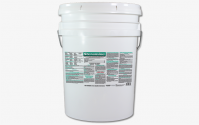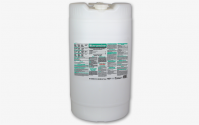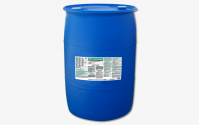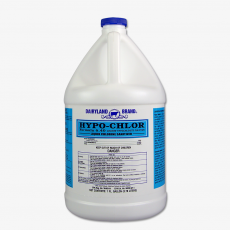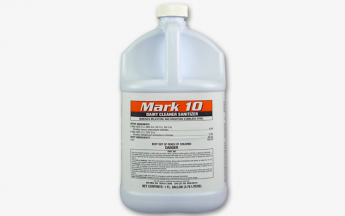You have 0 items in your cart.

Steramine® Farm & Veterinary
Use Steramine® as a manual sanitizer for bulk tanks, utensils, and dairy equipment. Deodorizes as well.
EPA Registration No. 10324-63-3640
| Product Number | 1205274, 1202778, 1202549 |
| Old Product # | ST-13, ST-147, ST-204 |
|
|
Sanitizers |
| EPA Registration No. | 10324-63-3640 |
#1205274 - 4x1 gallon case
#2103850 - 5 gallon pail
#1202778 - 15 gallon drum
#1202549 - 55 gallon drum
It is a violation of Federal Law to use this product in a manner inconsistent with its labeling.
PREPARATION OF DISINFECTION/FUNGICIDAL/VIRUCIDAL USE SOLUTION: Before using this product, food products and packaging materials must be removed from the room or carefully protected. Add 3 fluid ounces per 5 gallons of water (or equivalent use dilution) (469 ppm active quat) to disinfect hard non-porous surfaces. Apply this product with a cloth, mop or mechanical spray device. When applied with a mechanical spray device, surfaces must be sprayed until thoroughly wetted. Treated surfaces must remain wet for 10 minutes. For sprayer applications, use a coarse pump or trigger sprayer. Spray 6-8 inches from surface. Rub with brush, sponge or cloth. Do not breathe spray. Rinse or allow to air dry. Rinsing of floors is not necessary unless they are to be waxed or polished. Rinse all surfaces that come in contact with food such as countertops, appliances, tables and stovetops with potable water before reuse. Do not use this product to clean or disinfect utensils, glassware, dishes or interior surfaces of appliances. Prepare a fresh solution at least daily or when use solution becomes visibly dirty.
Note: With spray applications, cover or remove all food products. For heavily soiled areas, a preliminary cleaning is required.
FOOD CONTACT AND PROCESSING EQUIPMENT SANITIZING DIRECTIONS
Sanitizing of Food Processing Equipment and Other Hard Surfaces in Food Processing Locations, Dairies, Restaurants and Bars Directions: For sanitizing food processing equipment, dairy equipment, food utensils, dishes, silverware, glasses, sink tops, countertops, refrigerated storage and display equipment and other hard non-porous surfaces. NO POTABLE WATER RINSE IS ALLOWED.
Prior to application, remove gross food particles and soil by a pre-flush or pre-scrape and when necessary, presoak. Then thoroughly wash or flush objects with a good detergent or compatible cleaner, followed by a potable water rinse before applications of the sanitizing solution.
Before use as a sanitizer in federally inspected meat and poultry plants and dairies, food products and packaging materials must be removed from the room or carefully protected. A potable water rinse is not allowed following the use of this product as a sanitizer on previously cleaned hard nonporous surfaces provided that the surfaces are adequately drained before contact with food so that little or no residue remains.
Apply a solution of 1 ounce of this product in 4 gallons of water, (or equivalent use dilution) (200 ppm active) OR mix a 1 ounce packet with 4 gallons of water, to precleaned, hard surfaces thoroughly wetting surfaces with a cloth, mop, sponge, sprayer or by immersion. For spray applications, use a coarse pump or trigger sprayer. Spray 6 to 8 inches from surface, rub with brush, sponge, or cloth. Do not breathe spray. With spray applications cover or remove all food products. From a Closed Loop Dilution Center, apply 200 ppm active solution to the surface to be sanitized. Surfaces should remain wet for at least 1 minute followed by adequate draining and air drying. A fresh solution should be prepared at least daily or when use solution becomes visibly dirty. For mechanical application use solution may not be reused for sanitizing applications. NO POTABLE WATER RINSE IS ALLOWED AFTER APPLICATION OF THE SANITIZING SOLUTION.
Apply to sink tops, countertops, refrigerated storage and display equipment and other stationary hard surfaces by cloth or brush or mechanical spray device. NO POTABLE WATER RINSE IS ALLOWED after use as a sanitizer.
Dishes, silverware, glasses, cooking utensils and other similar size food processing equipment can be sanitized by immersion in a 1 ounce per 4 gallons solution of this product (200 ppm active). NO POTABLE WATER RINSE IS ALLOWED.
Dairy Cow Application Directions: The udders, flanks and teats of dairy cows can be washed with a solution of 1 oz of this product in 4 gallons of warm water. Use a fresh towel for each cow. Avoid contamination of wash solution by dirt and soil. Do not dip used towel back into wash solution. When solution becomes visibly dirty, discard and provide fresh solution.
SANITIZING EGG SHELLS INTENDED FOR FOOD DIRECTIONS
To sanitize previously cleaned food-grade eggs in shell egg and egg product processing plants, spray with a solution of 1 ounce of this product per 4 gallons of warm water (or equivalent use dilution) (200 ppm active). The solution should be warmer than the eggs, but not to exceed 130°F. Wet eggs thoroughly and allow to drain. Eggs sanitized with this product shall be subjected to a potable water rinse only if they are to be broken immediately for use in the manufacture of egg products. Eggs should be reasonably dry before casing or breaking. The solution should not be re-used for sanitizing eggs.
NOTE: Only clean, whole eggs can be sanitized. Dirty, cracked or punctured eggs cannot be sanitized.
Disinfection of Poultry/Turkey Equipment, Swine Quarters, Animal Quarters and Kennels. Prior to disinfection, remove all poultry, other animals and their feed from premises trucks, coops and crates. Remove all litter and droppings and manure from floors, walls and surfaces of barns, pens, stalls, chutes and other facilities and fixtures occupied or traversed by animals. Empty all troughs, racks and other feeding and watering appliances. Thoroughly clean all surfaces with soap or detergent and rinse with water. Use 4 ounces of this product per 5 gallons of water (or equivalent use dilution) (625 ppm active quat). Saturate surfaces with the recommended disinfecting solution for a period of 10 minutes. Immerse all halters, ropes and other types of equipment used in handling and restraining animals, as well as forks, shovels, and scrapers used for removing litter and manure.
After disinfection, ventilate buildings, coops and other closed spaces. Do not house poultry, or other animals or employ equipment until treatment has been absorbed, set or dried.
All treated equipment that will contact feed or drinking water (racks, troughs, automatic feeders, fountains and waterers) must be thoroughly scrubbed with soap or detergent then rinsed with potable water before reuse
Attachments
-
Technical Data Sheet
pdf | 1.19 MB | 1508 hits -
SDS
pdf | 375.79 KB | 1057 hits -
Efficacy Summary
pdf | 9.45 MB | 175 hits










